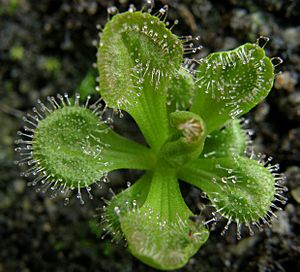Scented sundew facts for kids
Quick facts for kids Scented sundew |
|
|---|---|
 |
|
| Scientific classification | |
| Genus: |
Drosera
|
| Species: |
whittakeri
|
Drosera whittakeri is a special type of sundew plant. It's also known as the scented sundew or Whittaker's sundew. This plant grows naturally in South Australia. Sundews are famous for being carnivorous plants, meaning they catch and eat insects!
What Does the Scented Sundew Look Like?
This sundew plant usually grows to be about 4 to 8 centimeters wide. Its leaves are shaped like a spoon and spread out in a circle, like a rosette. These leaves can be green, orange-yellow, or even red. They are about 10 to 15 millimeters long and 9 to 13 millimeters wide.
The plant can grow up to 20 white flowers in total. Many of these flowers can be open at the same time. In its natural home, the main time for flowering is from May to November, but you might see flowers at other times of the year too.
How Was This Plant Named?
The Drosera whittakeri was officially described by a scientist named Jules Émile Planchon in 1848. He wrote about it in a science book called Annales des Sciences Naturelles.
The plant was named after Joseph Whittaker, a botanist from Derbyshire. A botanist is a scientist who studies plants. Joseph Whittaker collected many different plant samples from South Australia between 1839 and 1840.
Scientists sometimes recognize different types of the same species, called subspecies. For a while, two subspecies of Drosera whittakeri were known:
- Drosera whittakeri subsp. aberrans
- Drosera whittakeri Planch. subsp. whittakeri
However, in 2008, two other scientists, Allen Lowrie and John G. Conran, decided that Drosera whittakeri subsp. aberrans was different enough to be its own species. So, they gave it a new name: Drosera aberrans. They also suggested that another plant, Drosera praefolia, should be seen as its own species, not just a type of D. whittakeri.
See also
 In Spanish: Drosera whittakeri para niños
In Spanish: Drosera whittakeri para niños

